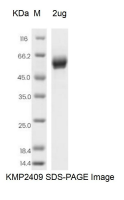Service Line:+86-022-82164980
Address:FL-4, Building A5, International Enterprise Community, Tianjin, China
Email:[email protected]
| Catalog Number | KMP2409 |
|---|---|
| Product Name | Human CD160 Protein, His Tag |
| Product Description | The Human CD160 Protein(KMP2409) is produced in HEK293 Cells and the target gene encoding Ile27-Ser159 is expressed with a 6His tag at the C-terminus. |
| Molecular Weight | 15.62 kDa |
| Alias | CD160 antigen, CD160 |
| Species | Human |
| Host | HEK293 Cells |
| Size | 50ug, 100ug, 200ug |
| Purification | Affinity purification |
| Purity | >90% as determined by SDS-PAGE |
| Endotoxin | <1.0 EU/ug determined by the LAL method |
| Buffer | 20mM PB, 150mM NaCl, pH7.4 |
| Uniprot | O95971 |
| SDS-PAGE |  |
| Function | CD160 antigen Receptor on immune cells capable to deliver stimulatory or inhibitory signals that regulate cell activation and differentiation. Exists as a GPI-anchored and as a transmembrane form, each likely initiating distinct signaling pathways via phosphoinositol 3-kinase in activated NK cells and via LCK and CD247/CD3 zeta chain in activated T cells . Receptor for both classical and non-classical MHC class I molecules . In the context of acute viral infection, recognizes HLA-C and triggers NK cell cytotoxic activity, likely playing a role in anti-viral innate immune response. On CD8+ T cells, binds HLA-A2-B2M in complex with a viral peptide and provides a costimulatory signal to activated/memory T cells . Upon persistent antigen stimulation, such as occurs during chronic viral infection, may progressively inhibit TCR signaling in memory CD8+ T cells, contributing to T cell exhaustion . On endothelial cells, recognizes HLA-G and controls angiogenesis in immune privileged sites . Receptor or ligand for TNF superfamily member TNFRSF14, participating in bidirectional cell-cell contact signaling between antigen presenting cells and lymphocytes. Upon ligation of TNFRSF14, provides stimulatory signal to NK cells enhancing IFNG production and anti-tumor immune response (By similarity). On activated CD4+ T cells, interacts with TNFRSF14 and down-regulates CD28 costimulatory signaling, restricting memory and alloantigen-specific immune response (PubMed:18193050). In the context of bacterial infection, acts as a ligand for TNFRSF14 on epithelial cells, triggering the production of antimicrobial proteins and pro-inflammatory cytokines (By similarity). CD160 antigen, soluble form The soluble GPI-cleaved form, usually released by activated lymphocytes, might play an immune regulatory role by limiting lymphocyte effector functions. |
| Background | CD160 antigen is a Lipid-anchor that exists as a disulfide-linked homomultimer. CD160 contains one Ig-like V-type domain. The human CD160 precursor is a cysteine-rich, glycosylphosphatidylinositol-anchored protein of 181 amino acids with a single Ig-like domain. It is weakly homologous to KIR2DL4. CD160 is expressed in the spleen, peripheral blood, and small intestine. Its expression is tightly associated with peripheral blood NK cells and CD8 T lymphocytes with cytolytic effector activity. CD160 is a receptor showing broad specificity for both classical and non-classical MHC class I molecules. |
| Storage | Aliquot and store at -20℃ to -80℃. Avoid repeated freezing and thawing cycles. |
| Note | This product is for research use only. |
| References | 1.Int. Immunol. 14:445-451 (2002) 2.Proc. Natl. Acad. Sci. U.S.A. 99:16963-16968 (2002) 3.Int. Immunol. 19:401-409 (2007) 4.Nat. Immunol. 9:176-185 (2008) 5.PLoS Pathog. 10:E1004380-E1004380 (2014) 6.J. Immunol. 178:1293-1300 (2007) |